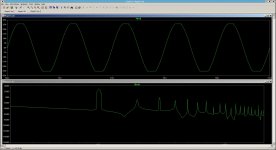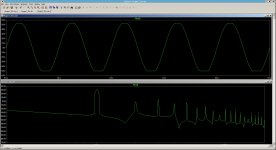Lately I'm interested in hybrid amps, that involve tubes.
My main "problem" is that as an output I don't want class A, (because of the power dissipation I will have to deal with and huge PSU) and most of the designs I found while googling are class A. Also, I don't like bipolars....
So, I'm looking at class A/B designs. I have in my box a few Toshiba sk1530-sj201,and some alfet 16n20-16p20. Has anybody used these in a/b mode?
Then I had this idea: Why not use a buffer as output stage? I've been looking at the LME49610 datasheet and it looks promising in specs, and easier to implement than the toshiba/alfet solution.
Let me back up a bit and say, the tube part will be consisting of 6sn7, 6sl7 tubes that I already have in my box, too. I was thinking a design like Broskie's Aikido..
Any thoughts so far?
Please note, that this will be my first atemp to design an amp from scratch, I don't have very deep pockets, and I want to do it mostly for the fun of it and the knowledge. If the result is something that gives me joy to listen to, even better!! So, please be gentle and elaborate.
Thanks!
My main "problem" is that as an output I don't want class A, (because of the power dissipation I will have to deal with and huge PSU) and most of the designs I found while googling are class A. Also, I don't like bipolars....
So, I'm looking at class A/B designs. I have in my box a few Toshiba sk1530-sj201,and some alfet 16n20-16p20. Has anybody used these in a/b mode?
Then I had this idea: Why not use a buffer as output stage? I've been looking at the LME49610 datasheet and it looks promising in specs, and easier to implement than the toshiba/alfet solution.
Let me back up a bit and say, the tube part will be consisting of 6sn7, 6sl7 tubes that I already have in my box, too. I was thinking a design like Broskie's Aikido..
Any thoughts so far?
Please note, that this will be my first atemp to design an amp from scratch, I don't have very deep pockets, and I want to do it mostly for the fun of it and the knowledge. If the result is something that gives me joy to listen to, even better!! So, please be gentle and elaborate.
Thanks!
A vs AB is just about bias. USe as many pairs as you have to increase transconductance, bias as high as you can while still maiantaining level of heat you want, use higher rails than Class A, and you are good. Execpt for distortion, that is😀
I'm reading the thread about the 6v6 stage by Salas. It's an option I'm also considering.
I'm looking for a way to "connect" the tube stage with the buffer(s). Could anybody advice on this? Simply connecting them with wires would be ok?
I'm trying to find a simulation program which has already in its library the valves in discussion and the buffer, but I can't find anything....
I'm looking for a way to "connect" the tube stage with the buffer(s). Could anybody advice on this? Simply connecting them with wires would be ok?
I'm trying to find a simulation program which has already in its library the valves in discussion and the buffer, but I can't find anything....
Build the f4 and 6v6 pre, and voila. No need to reinvent the wheel. They sound great together, btw.
f4 is class A right? So big toroids, dual mono, big CRC, huge heatsinks.....
I think the f5 is enough. The thing is around 30 kilos already....
I think the f5 is enough. The thing is around 30 kilos already....
From running simulations of designs like the Aikido and Mugen, it seems that a problem is that the solid state output stage tends to clip before the valve input stage does. The result is all the badness of silicon sound without much of the valve goodness. I have a hunch that it can be fixed by upping the supply voltage (and therefore power) of the output stage.
Here is a comparison of the output waveforms of two versions the amplifier - one with 38V as specified in the published version and one with 55V rails that only exists on my computer's hard drive. No component values were changed. The DC offset was tweaked to be about the same. Input levels were adjusted to give about the same level if distortion - 4.5% for the 38V version and 5.5% for the 55V version.
The result is that the 55V output looks somewhat nicer and appears to have a lower magnitude of distortion harmonics above 10kHz. Not quite conclusive evidence yet, but worthy of further investigation?
I have experimented with a circuit that allows the user to adjust the amount of overdrive/clipping. This is of course interesting to guitarists but of little use in hi-fi. I then tried a tube input stage from a guitar amp with a MOSFET current buffer, with some interesting results. Refer to this thread for the detail:
 BJT/tube hybrid power amp with adjustable distortion
BJT/tube hybrid power amp with adjustable distortion
I tried to adapt the guitar design for general use, but the frequency response is far from flat and rolls off sharply above 10kHz! My knowledge of tube design is [still] too limited to fix this.
Another avenue not yet explored would be to substitute the tubes in a hybrid input stage for ones with lower gain, so that they are overdriven at a lower input voltage.
Here is a comparison of the output waveforms of two versions the amplifier - one with 38V as specified in the published version and one with 55V rails that only exists on my computer's hard drive. No component values were changed. The DC offset was tweaked to be about the same. Input levels were adjusted to give about the same level if distortion - 4.5% for the 38V version and 5.5% for the 55V version.
The result is that the 55V output looks somewhat nicer and appears to have a lower magnitude of distortion harmonics above 10kHz. Not quite conclusive evidence yet, but worthy of further investigation?
I have experimented with a circuit that allows the user to adjust the amount of overdrive/clipping. This is of course interesting to guitarists but of little use in hi-fi. I then tried a tube input stage from a guitar amp with a MOSFET current buffer, with some interesting results. Refer to this thread for the detail:
I tried to adapt the guitar design for general use, but the frequency response is far from flat and rolls off sharply above 10kHz! My knowledge of tube design is [still] too limited to fix this.
Another avenue not yet explored would be to substitute the tubes in a hybrid input stage for ones with lower gain, so that they are overdriven at a lower input voltage.
Attachments
Thank you ingenius!
I will take a good look at the info you provided.
( I wonder, if I choose buffer for the output would the same problem occur? Have to check this in the datasheet)
I will take a good look at the info you provided.
( I wonder, if I choose buffer for the output would the same problem occur? Have to check this in the datasheet)
- Status
- Not open for further replies.
- Home
- Amplifiers
- Tubes / Valves
- Yet Another Hybrid Amplifier

